|
|
|
| PROJECT APOLLO - Program Introduction - Part 1 | |
|
"No single space project will be more exciting, or more impressive, or more important for the long-range exploration of space, none will be so difficult or expensive to accomplish." In five short years man will be circling the moon and preparing for the great adventure - landing on the moon's surface. Today, it is a challenging national program - perhaps the most ambitious scientific project ever attempted - gathering momentum throughout a vast complex of facilities across the nation under the direction of the National Aeronautics and Space Administration. In the California plant of North American Aviation's space and Information Systems Division is a squat, conical, full-scale mock-up of the Apollo spacecraft that will carry American astronauts on circumlunar flights and to landings on the moon. North American is the prime contractor for the spacecraft. In Cedar Rapids, Iowa, engineers of Collins Radio Company are busy putting theory into practical application for the telecommunication system. In Minneapolis other scientists are working on the stability and control system. In the south, firms are working on the myriad development areas involved in a manned lunar capsule - the life support system, solid-fuel escape rocket, parachute system and reaction controls. |
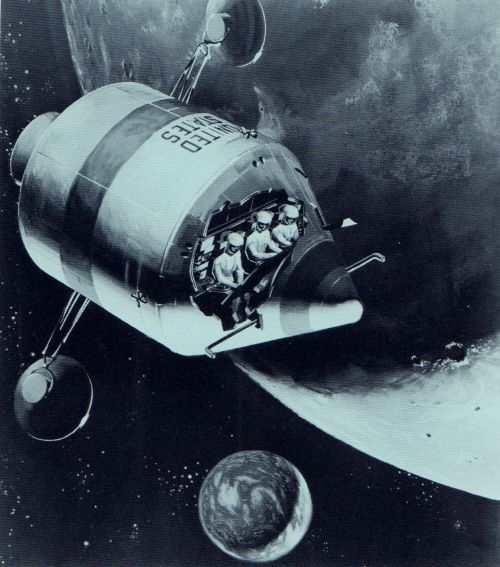 Artist's Rendering of Apollo Command Module |
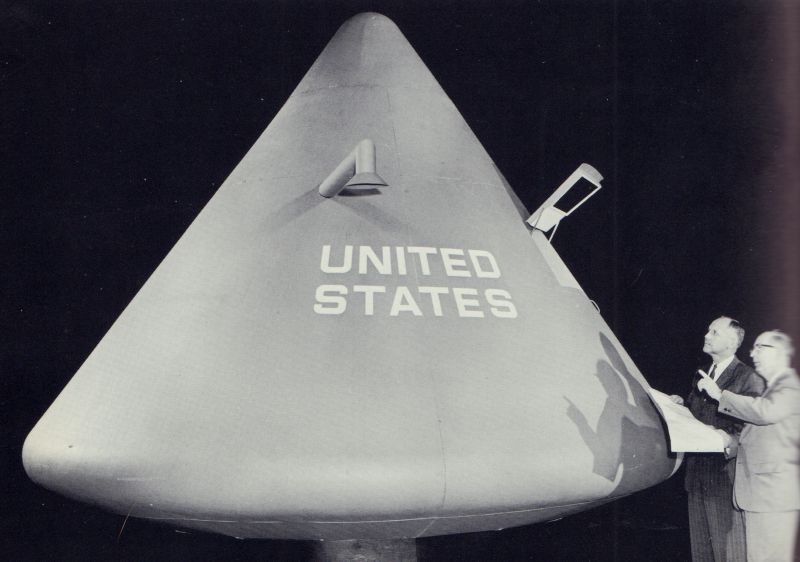 Prototype of NASA's Apollo spacecraft, built at North American Aviation's Space and Information Systems Division in Downy, Calif. |
|
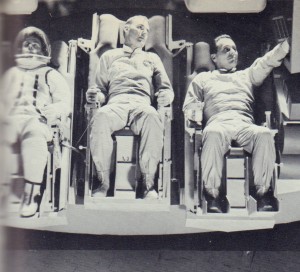 Configuration of three-man spacecraft includes fully adjustable seats. |
Today the Apollo capsule is made of wood, but in a quick tomorrow it will be the most complex manned spacecraft ever built by the United States and mounted atop a gigantic, multi-stage rocket at Cape Canaveral. Thirteen feet in base diameter, 14 feet high, the grey-painted mock-up is the sure shadow of history that will chronicle the first American explorations of deep space - and if determination has anything to do with it, history's first manned landing on the moon. The complete Apollo spacecraft, as it will be launched from earth on its lunar voyage, will comprise three main modules or sections that will stand five stories high. As presently envisioned, lunar orbit rendezvous technique will be used which would require a single launch of a Saturn C-5 boosting the 13-foot diameter spacecraft. The spacecraft would include a five ton, 12-foot tall command module housing the crew; a 23-ton, 23-foot tall service module providing mid-course correction and return-to-earth propulsion; and a 15-ton, 20-foot tall lunar excursion module. The three modules would proceed to the vicinity of the moon and would be placed in lunar orbit as a unit. Two astronauts would then transfer to the lunar excursion vehicle and descend to the moon while the Apollo mother craft (command-service modules) remains in lunar orbit. |
|
After a period of exploration extending up to four days, the two men would use the lunar excursion vehicle to ascend from the moon to rendezvous with the Apollo mother craft in lunar orbit. After crew transfer, the lunar excursion vehicle would be jettisoned and the command module carrying the three-man team would be boosted back toward earth by the service module with an engine generating 20,000 pounds thrust. Just before entering the earth's atmosphere, the service module would be jettisoned and the command module oriented for re-entry. During the 2½day journey to the vicinity of the moon, the three astronauts are performing many important functions in a weightless condition. They keep close tabs on solar radiation levels, and are constantly alert to the threat of solar flare. The astronauts navigate and control their spacecraft by taking bearings on the earth, moon and stars. They can turn the spacecraft in various directions to facilitate navigation and communication with the earth. Periodically, they check out every piece of operating equipment in the spacecraft and report back to earth. They are performing numerous scientific observations including those of a medical nature. They are reporting periodically on their physical and mental condition. | 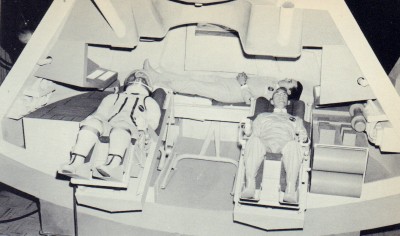 Astronauts recline for lift-off; assume sitting position douring jounrey. |
|
Earth orbital rendezvous techniques using command and service modules now under development also have been studied. This method required the additional development of two propulsion modules weighing about 50 tons - a lunar braking module and a lunar touchdown module - in order to decelerate the 28-ton command and service modules to a soft landing on the lunar surface. Under concepts emerging from most recent studies, earth orbit rendezvous, using the three-man Apollo, would have required earth launchings of two or more advanced systems. One vehicle would boost into orbit a 60-foot tall liquid oxygen tanker weighing some 110 tons. It would rendezvous with the separately launched modular spacecraft attached to a fueled third stage of a Saturn C-5. |
|
 John W. Paup |
A three-man direct flight would have the same requirements as earth orbital rendezvous for the command and service modules and the lunar braking and touchdown stages. In addition, this mode required the immediate development of the Nova vehicle with a 12 million pound thrust first stage and upper stages employing the 1.2 million pound thrust hydrogen-oxygen M-1 engines. The spacecraft will first be flown in earth orbit to test and evaluate its many systems and components and for crew training and the development of operational techniques such as orbital rendezvous. In conjunction with these qualification flights, it will be used in earth orbit as a laboratory for scientific measurements and technological development. Then it will be flown to increasingly greater distances from earth until manned circumlunar flight is achieved. The Apollo flight crew, as currently planned, will consist of three men: a spacecraft commander-pilot, a navigator-co-pilot and a systems manager. Both pilots will be thoroughly trained in propulsion and attitude control, navigation, on-board computer calculations and over-all systems operation. The systems manager will be trained in the pilot's position, but his primary responsibility will be the management of various propulsion systems, particularly during lunar landing and takeoff. |
|
The three men will ride side by side on launch (on their backs as in the Mercury capsule) and will wear space suits during the critical phase. During the two-and-a-half days it will take across cislunar space, however, and on the return flight, they may discard their space suits and work - or relax - in a shirtsleeve environment. It is probable, however, that at least one member of the crew will be wearing his space suit at all times for protection of craft and crew in case of emergency. As the command module with its lunar excursion vehicle nears the moon, two astronauts will prepare to transfer to the landing vehicle for touchdown on the surface. The human-factor problem of man in space on Apollo lunar missions includes the effects of long periods of weight-lessness, the intensity and nature of radiation emanating from solar disturbances, and the physiological and psychological effects of close confinement on a long arduous mission. |
|
|
For the final approach, the astronauts will be assisted by precise ground tracking instruments as they approach the re-entry corridor. The command module will hurtle through the atmosphere subjected to maximum temperatures and acceleration encountered during the mission. At about 10,000 feet, the large parachutes will be deployed to bring the capsule safely to earth. Landing will occur in a pre-designated and prepared area where the capsule will be tracked by many radars and optical instruments. When the capsule is down, recovery teams will proceed immediately to the landing point to pick up the astronauts. The accuracy of the re-entry maneuver into a 40-mile-wide "window" several hundred miles above the earth's surface, at 25,000 mph, will be about equal to hitting an object the size of a nickel at the end of a football field with a baseball. Nor will Apollo have retro-rockets to slow its speed. Instead, a unique offset center of gravity design will enable the pilots to "fly" the capsule in re-entry phase, actually climb and drive it to some degree to guide it through the maneuver as it slows in increasingly heavier air. Thus the crew will have a measure of control as to where the vehicle lands and can prevent it diving too steeply to incineration or re-entering at too shallow an angle which would cause it to skip back into space. |
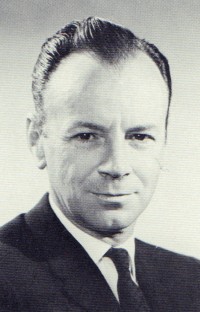 Harrision A. Storms, Jr. |
|
Science fiction? Sounds like it, but it isn't. There are men living today who will make the Bight in that quick tomorrow. |
|
| —Collins Signal, Issue 47, Volume 10-3, 1962 - Pages 9-12 | |